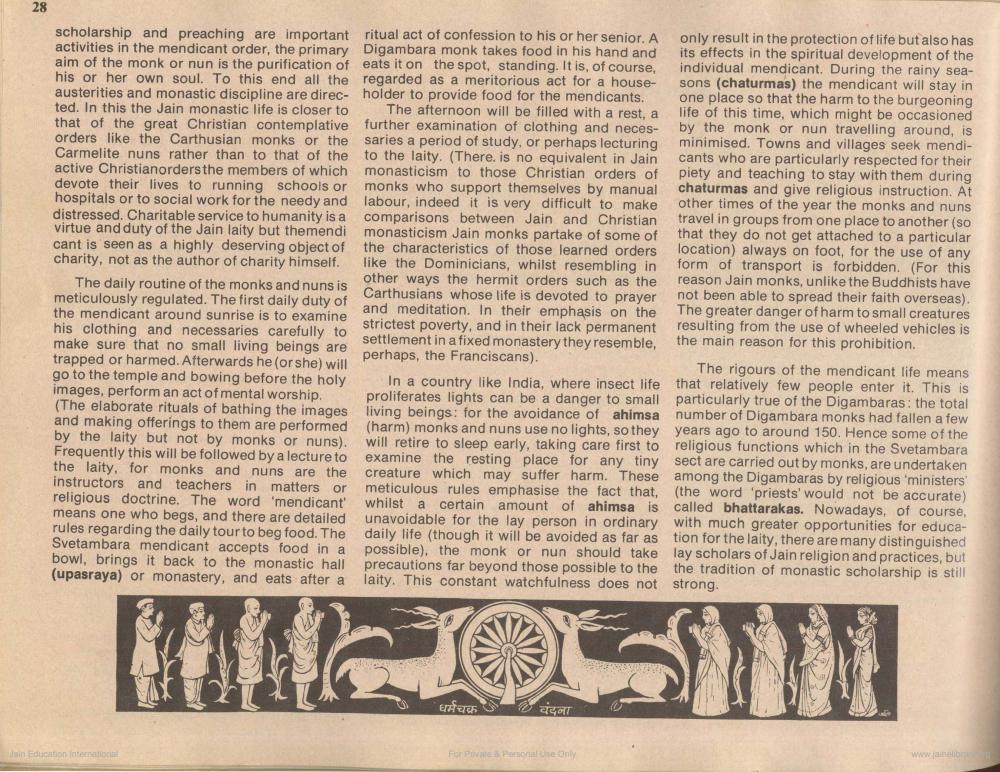________________
scholarship and preaching are important ritual act of confession to his or her senior. A only result in the protection of life but also has activities in the mendicant order, the primary Digambara monk takes food in his hand and its effects in the spiritual development of the aim of the monk or nun is the purification of eats it on the spot, standing. It is, of course, individual mendicant. During the rainy seahis or her own soul. To this end all the regarded as a meritorious act for a house- sons (chaturmas) the mendicant will stay in austerities and monastic discipline are direc- holder to provide food for the mendicants. one place so that the harm to the burgeoning ted. In this the Jain monastic life is closer to the afternoon will be filled with a rest, a life of this time, which might be occasioned that of the great Christian contemplative further examination of clothing and neces- by the monk or nun travelling around, is orders like the Carthusian monks or the saries a period of study, or perhaps lecturing minimised. Towns and villages seek mendiCarmelite nuns rather than to that of the to the laity. (There is no equivalent in Jain cants who are particularly respected for their active Christianorders the members of which monasticism to those Christian orders of piety and teaching to stay with them during devote their lives to running schools or monks who support themselves by manual chaturmas and give religious instruction. At hospitals or to social work for the needy and labour, indeed it is very difficult to make other times of the year the monks and nuns distressed. Charitable service to humanity is a comparisons between Jain and Christian travel in groups from one place to another (so virtue and duty of the Jain laity but themendi monasticism Jain monks partake of some of
that they do not get attached to a particular cant is seen as a highly deserving object of the characteristics of those learned orders location) always on foot, for the use of any charity, not as the author of charity himself. like the Dominicians, whilst resembling in form of transport is forbidden. (For this The daily routine of the monks and nuns is
other ways the hermit orders such as the reason Jain monks, unlike the Buddhists have
Carthusians whose life is devoted to prayer not been able to spread their faith overseas). meticulously regulated. The first daily duty of
and meditation. In their emphasis on the The greater danger of harm to small creatures the mendicant around sunrise is to examine
strictest poverty, and in their lack permanent resulting from the use of wheeled vehicles is his clothing and necessaries carefully to
settlement in a fixed monastery they resemble, the main reason for this prohibition. make sure that no small living beings are
perhaps, the Franciscans). trapped or harmed. Afterwards he (or she) will
The rigours of the mendicant life means go to the temple and bowing before the holy In a country like India, where insect life that relatively few people enter it. This is images, perform an act of mental worship. proliferates lights can be a danger to small particularly true of the Digambaras: the total (The elaborate rituals of bathing the images living beings for the avoidance of ahimsa number of Digambara monks had fallen a few and making offerings to them are performed (harm) monks and nuns use no lights, so they years ago to around 150. Hence some of the by the laity but not by monks or nuns). will retire to sleep early, taking care first to religious functions which in the Svetambara Frequently this will be followed by a lecture to examine the resting place for any tiny sect are carried out by monks, are undertaken the laity. for monks and nuns are the creature which may suffer harm. These among the Digambaras by religious 'ministers instructors and teachers in matters or meticulous rules emphasise the fact that, (the word 'priests' would not be accurate) religious doctrine. The word 'mendicant whilst a certain amount of ahimsa is called bhattarakas. Nowadays, of course, means one who begs, and there are detailed unavoidable for the lay person in ordinary with much greater opportunities for educarules regarding the daily tour to beg food. The daily life (though it will be avoided as far as tion for the laity, there are many distinguished Svetambara mendicant accepts food in a possible), the monk or nun should take lay scholars of Jain religion and practices, but bowl, brings it back to the monastic hall precautions far beyond those possible to the the tradition of monastic scholarship is still (upasraya) or monastery, and eats after a Taity. This constant watchfulness does not strong.
धर्मचकचंदना
P
eny




